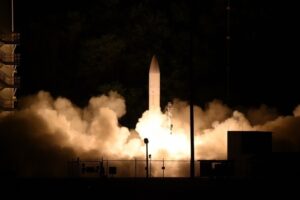The Army is looking to resume testing of its Long Range Hypersonic Weapon (LRHW) by this summer, officials have said, which follows a series of canceled tests last year that delayed the service’s planned fielding goal.
Army Under Secretary Gabe Camarillo told reporters this week the Army is “guardedly optimistic” on restarting the LRHW test plan, noting the service has been working with the Navy to address issues that led to the delays.

“So it’s a [collaborative effort], as we always say with the Navy, and we’ve been working very closely with them to deal with some of the root cause analysis and to develop a test plan that will hopefully get us back to, you know, a test launch this later this summer,” Camarillo said during a Monday press briefing on the Army’s FY ‘25 budget request. “We remain guardedly optimistic that we’ll be able to do that. And, you know, the rest of the funding that’s in the [FY] ’25 submission is for continued development and ultimately procurement of that system.”
The Army’s LRHW, which has been in development for over four years, will share the same all-up missile round and canister, and Common Hypersonic Glide Body (C-HGB) with the Navy’s Conventional Prompt Strike program.
In 2019, the Army chose Lockheed Martin [LMT] to serve as the weapon systems integrator for the LRHW, which will be fired from a truck, while Dynetics [LDOS] is tasked with producing the C-HGB.
The Army’s $185.9 billion budget request includes over $1.2 billion in LRHW funding, split between $744 million in procurement and $538 million for further research and development and testing.
The service’s budget documents note the requested funding continues the development of the C-HGB and covers a planned procurement of further ground support equipment and a basic load of eight All-Up Rounds.
“For the Army, the critical thing would be an integrated test using launcher and missile that provides confidence in the end-to-end capabilities so we can actually field live rounds,” Doug Bush, the Army’s acquisition chief, told reporters on Monday.
The Army completed fielding of the ground equipment for its first prototype hypersonic weapon battery, minus the live rounds, in the fall of 2021 to the soldiers from the I Corps’ 5th Battalion, 3rd Field Artillery Regiment, 17th Field Artillery Brigade at Joint Base Lewis-McChord in Washington, who have been testing on the equipment since then.
Following a series of three canceled live fire tests last year, the Army confirmed it would not meet its goal to field the first operational system with live rounds by the end of 2023 (Defense Daily, Nov. 8).
During a House Armed Services Strategic Forces Subcommittee hearing on Tuesday, lawmakers pressed the lead Army and Navy officials on the services’ efforts to address the lingering hypersonic weapon issues that led to the canceled demonstrations.
“I appreciate the work your teams are doing to identify and fix the malfunctions that caused the unsuccessful flight tests and get the programs on track to field these critical capabilities. However, at this point we are still well behind our adversaries even if everything goes as planned,” Rep. Doug Lamborn (R-Colo.), the subcommittee’s chair, said during the hearing.
Lt. Gen. Robert Rasch, director of the Army’s Rapid Capabilities and Critical Technologies Office, which has been leading the service’s hypersonic weapon development, said the Army has been working with the Navy on a “deep dive into some of the system design aspects” following the test challenges, to include “a complete system analysis” to “uncover any additional trouble spots”
Rasch added an independent review team has also been stood up to ensure the Army and Navy do not miss additional technical issues that could further delay testing efforts.
“While those tests [last year] did not go as planned, the Army and Navy teams learned from each of these and worked with industry to make necessary corrective actions to return to the range for further testing,” Rasch said. “Following the third attempt, both programs worked together to establish multiple lines of effort to conduct a series of design reviews across the weapon system. In close partnership with the Navy, we are pursuing a rigorous test regimen to reduce risk before returning back to flight test. This regimen will ensure success at the subsystem level, making necessary adjustments and demonstrating repeated success, allowing us to return to flight test with unwavering confidence.”
Vice Adm. Johnny Wolfe Jr., the Navy’s director of strategic systems programs, reiterated the testing delays have also pushed back the planned fielding of the service’s Conventional Prompt Strike hypersonic weapon by at least a year.
“We’ve hit some hiccups and we’re learning from that,” Wolfe said during the hearing. “A lot of this has been just understanding how we actually put this in the warfighters’ hands. It’s not necessarily a technology challenge. It’s [about] ramping up industry to produce these things reliably so that we can get them to our warfighter”